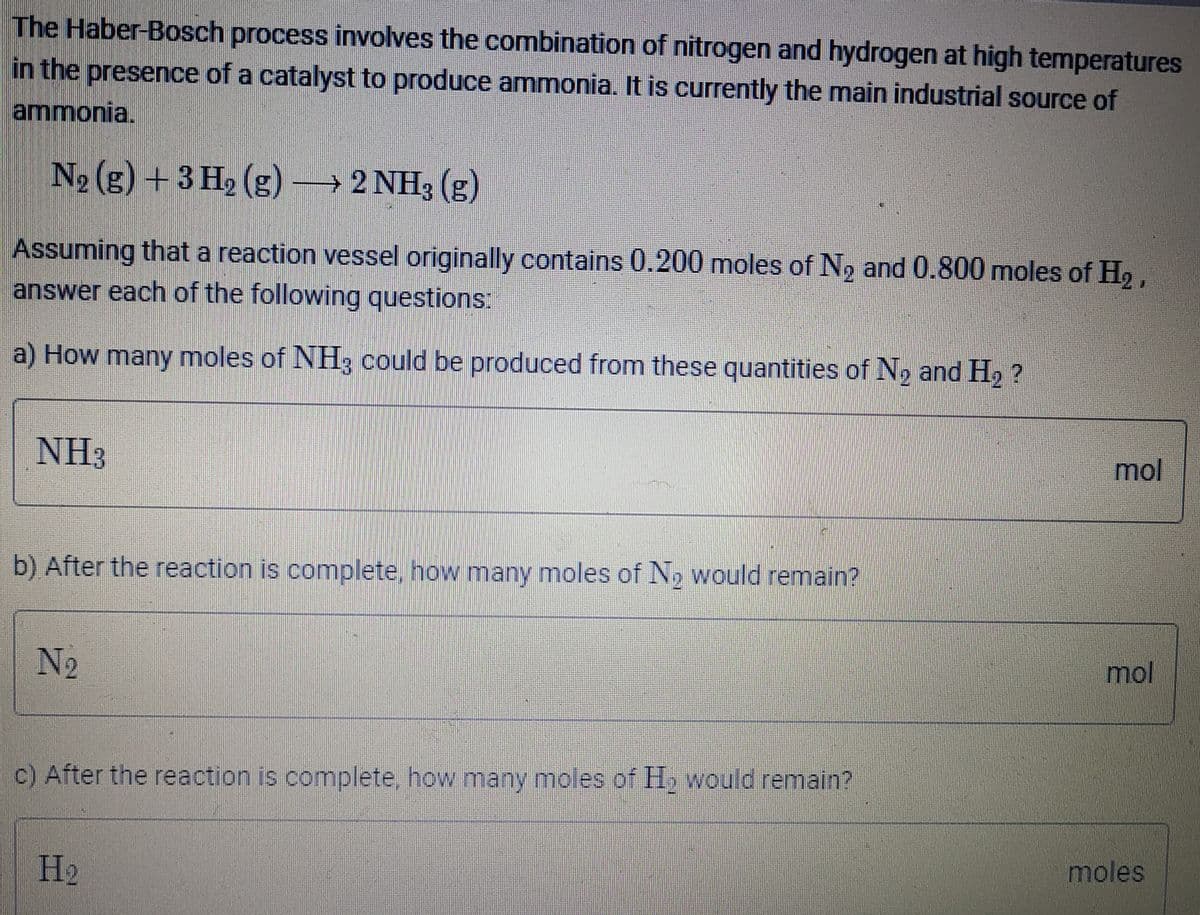The Haber-Bosch process involves the combination of nitrogen and hydrogen at high temperatures in the presence of a catalyst to produce ammonia. It is currently the main industrial source of ammonia. N2 (g) + 3 H2 (g) 2 NH3 (g) Assuming that a reaction vessel originally contains 0.200 moles of N, and 0.800 moles of H2 , answer each of the following questions: a) How many moles of NH3 could be produced from these quantities of N, and H2 ? NH3 mol b) After the reaction is complete, how many moles of No would remain? mol N2 c) After the reaction is complete, how many moles of H, would remain? moles H2
The Haber-Bosch process involves the combination of nitrogen and hydrogen at high temperatures in the presence of a catalyst to produce ammonia. It is currently the main industrial source of ammonia. N2 (g) + 3 H2 (g) 2 NH3 (g) Assuming that a reaction vessel originally contains 0.200 moles of N, and 0.800 moles of H2 , answer each of the following questions: a) How many moles of NH3 could be produced from these quantities of N, and H2 ? NH3 mol b) After the reaction is complete, how many moles of No would remain? mol N2 c) After the reaction is complete, how many moles of H, would remain? moles H2
Chemistry: Matter and Change
1st Edition
ISBN:9780078746376
Author:Dinah Zike, Laurel Dingrando, Nicholas Hainen, Cheryl Wistrom
Publisher:Dinah Zike, Laurel Dingrando, Nicholas Hainen, Cheryl Wistrom
Chapter11: Stoichiometry
Section: Chapter Questions
Problem 9STP
Related questions
Question

Transcribed Image Text:The Haber-Bosch process involves the combination of nitrogen and hydrogen at high temperatures
in the presence of a catalyst to produce ammonia. It is currently the main industrial source of
ammonia.
N2 (g) + 3 H2 (g) 2 NH3 (g)
Assuming that a reaction vessel originally contains 0.200 moles of N, and 0.800 moles of H,,
answer each of the following questions:
a) How many moles of NH, could be produced from these quantities of No and H, ?
NH3
mol
b) After the reaction is complete, how many moles of No would remain?
N2
mol
c) After the reaction is complete, how many moles of H, would remain?
H2
moles
Expert Solution
This question has been solved!
Explore an expertly crafted, step-by-step solution for a thorough understanding of key concepts.
This is a popular solution!
Trending now
This is a popular solution!
Step by step
Solved in 3 steps

Knowledge Booster
Learn more about
Need a deep-dive on the concept behind this application? Look no further. Learn more about this topic, chemistry and related others by exploring similar questions and additional content below.Recommended textbooks for you

Chemistry: Matter and Change
Chemistry
ISBN:
9780078746376
Author:
Dinah Zike, Laurel Dingrando, Nicholas Hainen, Cheryl Wistrom
Publisher:
Glencoe/McGraw-Hill School Pub Co

Chemistry: Principles and Reactions
Chemistry
ISBN:
9781305079373
Author:
William L. Masterton, Cecile N. Hurley
Publisher:
Cengage Learning

Chemistry by OpenStax (2015-05-04)
Chemistry
ISBN:
9781938168390
Author:
Klaus Theopold, Richard H Langley, Paul Flowers, William R. Robinson, Mark Blaser
Publisher:
OpenStax

Chemistry: Matter and Change
Chemistry
ISBN:
9780078746376
Author:
Dinah Zike, Laurel Dingrando, Nicholas Hainen, Cheryl Wistrom
Publisher:
Glencoe/McGraw-Hill School Pub Co

Chemistry: Principles and Reactions
Chemistry
ISBN:
9781305079373
Author:
William L. Masterton, Cecile N. Hurley
Publisher:
Cengage Learning

Chemistry by OpenStax (2015-05-04)
Chemistry
ISBN:
9781938168390
Author:
Klaus Theopold, Richard H Langley, Paul Flowers, William R. Robinson, Mark Blaser
Publisher:
OpenStax


Chemistry
Chemistry
ISBN:
9781305957404
Author:
Steven S. Zumdahl, Susan A. Zumdahl, Donald J. DeCoste
Publisher:
Cengage Learning

Chemistry: An Atoms First Approach
Chemistry
ISBN:
9781305079243
Author:
Steven S. Zumdahl, Susan A. Zumdahl
Publisher:
Cengage Learning